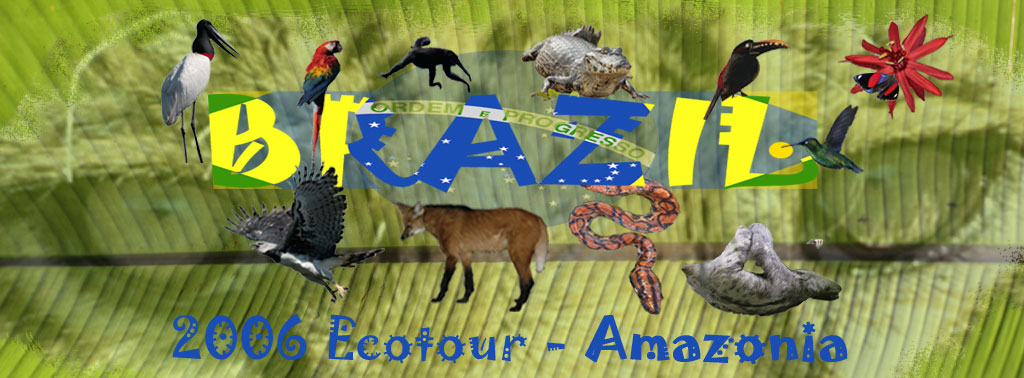



Added 3 September 2006
Day 11: Friday, June 16, 2006
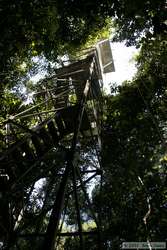 In the morning, we had breakfast at 5:45 so we could get an early start on our morning activity, which was a hike to the viewing tower near the lodge. At breakfast, we got a good laugh at Chuck's early morning experience. A screaming piha (Lipaugus vociferans), which we heard constantly but never once saw, started, well, screaming, right outside their bungalow. It woke him up and in the fog of sleep he thought that a fire alarm was going off.
In the morning, we had breakfast at 5:45 so we could get an early start on our morning activity, which was a hike to the viewing tower near the lodge. At breakfast, we got a good laugh at Chuck's early morning experience. A screaming piha (Lipaugus vociferans), which we heard constantly but never once saw, started, well, screaming, right outside their bungalow. It woke him up and in the fog of sleep he thought that a fire alarm was going off. 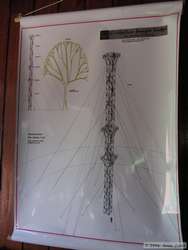 I guess he kind of stumbled around a bit before realizing it was a bird. After that, we started calling them the "fire alarm bird." Their call is truly loud.
I guess he kind of stumbled around a bit before realizing it was a bird. After that, we started calling them the "fire alarm bird." Their call is truly loud. 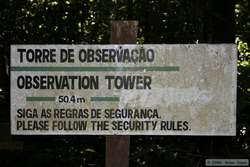 To get some sense of it, turn the volume up all the way on your computer and play
To get some sense of it, turn the volume up all the way on your computer and play
this sound file of the screaming piha. I really do mean crank it, by the way.
After an enjoyable breakfast, we headed to the tower. The tower is a little over 50 meters tall, and extends above the canopy of the forest, so it is a great place to view not only the forest itself, but also birds that remain in the upper levels of the forest.
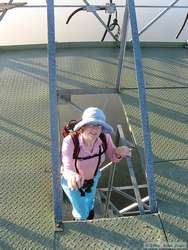
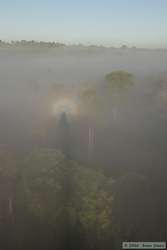
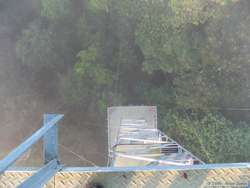 When we got to the tower, it was quite foggy, so at first we could hear many birds, but saw none. We spent quite a bit of time in the tower simply waiting for the fog to lift, so missed the prime viewing time, but we still picked up about 18 new species of birds in the several hours we spent at the top of the tower, including blue-winged macaw (Ara maracana), channel-billed toucan (Ramphastos vitellinus), blue-headed parrot (Pionus menstruus), white-bellied parrot (Pionites leucogaster), and painted parakeet (Pyrrhura picta), all amazingly gorgeous.
When we got to the tower, it was quite foggy, so at first we could hear many birds, but saw none. We spent quite a bit of time in the tower simply waiting for the fog to lift, so missed the prime viewing time, but we still picked up about 18 new species of birds in the several hours we spent at the top of the tower, including blue-winged macaw (Ara maracana), channel-billed toucan (Ramphastos vitellinus), blue-headed parrot (Pionus menstruus), white-bellied parrot (Pionites leucogaster), and painted parakeet (Pyrrhura picta), all amazingly gorgeous.
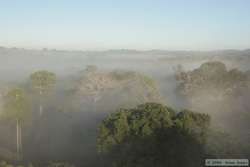
|
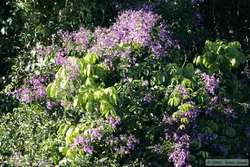
|
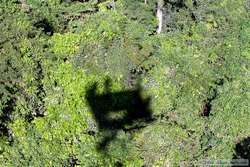
|
We also saw more scarlet macaw (Ara macao). There was something special about seeing the scarlet macaw in particular, that was thrilling. To see them flying over the tree tops was amazing. We also got to see a tiny hawk (Accipiter superciliosus), and yes, that is it's name, tiny hawk.
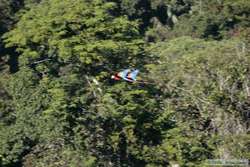
|
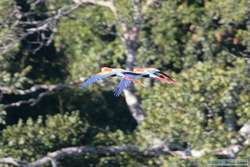
|
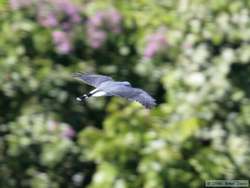
|
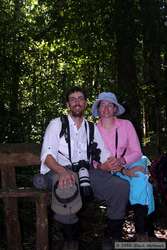 Before long, it was pretty warm, given that there is no shade, so we descended the tower to get some shade and explore the forest a bit.
Before long, it was pretty warm, given that there is no shade, so we descended the tower to get some shade and explore the forest a bit.
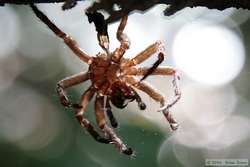
|
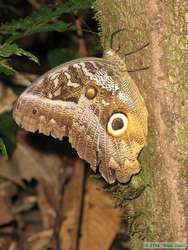
|
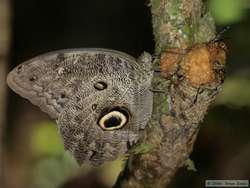
|
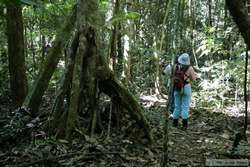
|
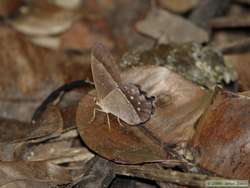
|
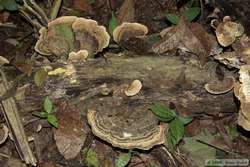
|
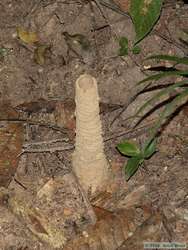
|
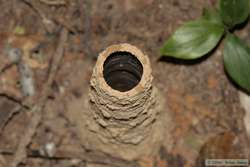
|
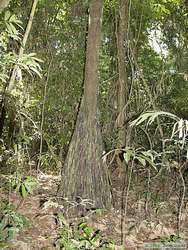
|
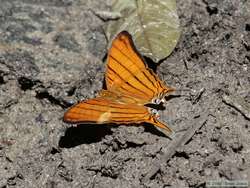
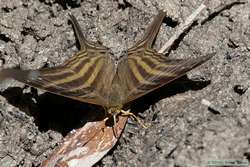 After the tower, we went to another wildlife viewing tower, this one only several meters high, and located at an area where there is salty water and soil which attracts mammals such as tapir, peccary, and others. There weren't any mammals when we got there, but there were swarms of butterflies flitting around. They too were attracted by the salt, which is in short supply throughout much of the Amazon. Salt licks always seem to be associated with great places to watch wildlife as animals try to fulfill this important nutritional need. I enjoyed trying to get pictures of the many different species of butterfly, many of which were quite beautiful.
After the tower, we went to another wildlife viewing tower, this one only several meters high, and located at an area where there is salty water and soil which attracts mammals such as tapir, peccary, and others. There weren't any mammals when we got there, but there were swarms of butterflies flitting around. They too were attracted by the salt, which is in short supply throughout much of the Amazon. Salt licks always seem to be associated with great places to watch wildlife as animals try to fulfill this important nutritional need. I enjoyed trying to get pictures of the many different species of butterfly, many of which were quite beautiful.
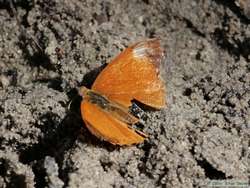
|
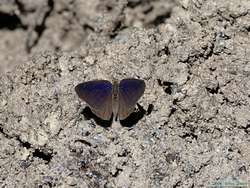
|
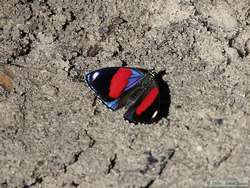
|
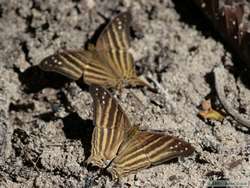
|
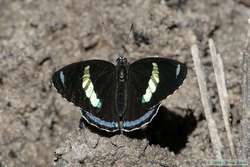
|
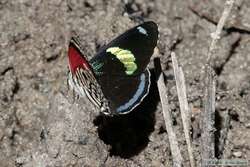
|
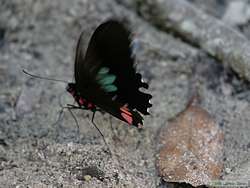
|
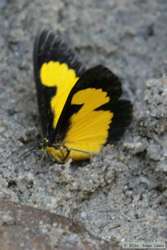
|
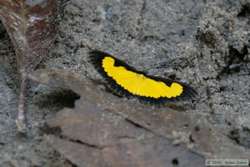
|
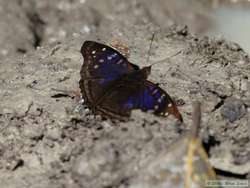
|
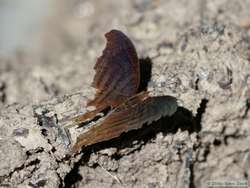
|
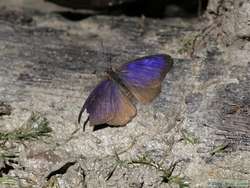
|
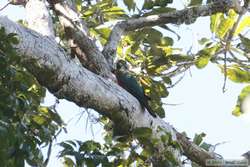 By the time we headed back, it was late morning, so there wasn't much action in the forest, so I focused on the interesting leaf forms I found along the trail. I also saw what I think is a pearly parakeet (Pyrrura lepida) (right).
By the time we headed back, it was late morning, so there wasn't much action in the forest, so I focused on the interesting leaf forms I found along the trail. I also saw what I think is a pearly parakeet (Pyrrura lepida) (right).
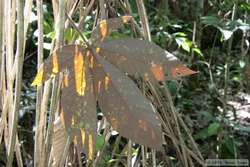
|
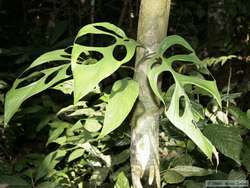
|
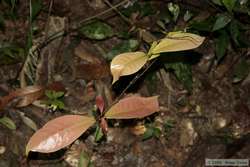
|
When we got back to the lodge, we enjoyed a cold drink, which was really nice after a very sticky morning at the tower. 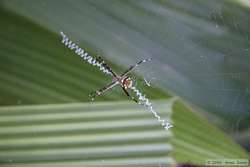 Shan tried suco de caju, or cashew juice, but it was really bad. I put a bunch of sugar in it, which made it slightly better, and just downed it to get it over with. After getting our drinks, Shan went back to the room for a nap and I decided to go hang out at the floating platform in the river. I passed Chuck, Dave and Fabricio at the lodge and found the platform uninhabited. I had a cold Antárctica (like Sprite or 7-Up), a comfortable chair, an occasional cooling breeze, and a beautiful view. I was as happy as a kitten following a leaky cow, as the saying goes. The wasps and butterflies, on the other hand, were as happy as, well, insects on a salt lick. They decided they liked the sweat salt on my legs and plied up and down them licking me as I sat there. Both the butterflies and wasps were ticklish though, so it wasn't always easy to let them enjoy my salt. It's a good thing I have no fear of stinging things. Only when a wasp got too close to someplace where it might get trapped or pinched if I shifted (like near my sandal straps) would I shoo them away.
Shan tried suco de caju, or cashew juice, but it was really bad. I put a bunch of sugar in it, which made it slightly better, and just downed it to get it over with. After getting our drinks, Shan went back to the room for a nap and I decided to go hang out at the floating platform in the river. I passed Chuck, Dave and Fabricio at the lodge and found the platform uninhabited. I had a cold Antárctica (like Sprite or 7-Up), a comfortable chair, an occasional cooling breeze, and a beautiful view. I was as happy as a kitten following a leaky cow, as the saying goes. The wasps and butterflies, on the other hand, were as happy as, well, insects on a salt lick. They decided they liked the sweat salt on my legs and plied up and down them licking me as I sat there. Both the butterflies and wasps were ticklish though, so it wasn't always easy to let them enjoy my salt. It's a good thing I have no fear of stinging things. Only when a wasp got too close to someplace where it might get trapped or pinched if I shifted (like near my sandal straps) would I shoo them away.
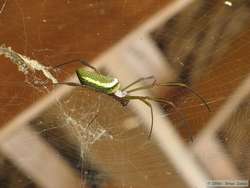
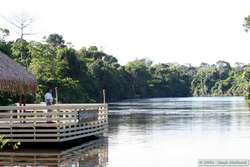 I wasn't there long before Chuck and Dave made their way down, and we sat together for a while. When Chuck saw the spider at left, he freaked out. It was then that I discovered that Chuck has a massive fear of large spiders, a fear that was altogether unexpected. While there we heard, then saw, a juvenile great black-hawk (Buteogallus urubitinga). We also some spider monkeys, though briefly. Unfortunately, I was unprepared and didn't have my camera or even my binos. We also met Erin, who appears to be Scott's girlfriend, when the two of them came down for a swim in the river. At lunch, Scott, Erin, Larry and Carolyn ended up sitting with Shan and I, and we had a pretty nice chat.
I wasn't there long before Chuck and Dave made their way down, and we sat together for a while. When Chuck saw the spider at left, he freaked out. It was then that I discovered that Chuck has a massive fear of large spiders, a fear that was altogether unexpected. While there we heard, then saw, a juvenile great black-hawk (Buteogallus urubitinga). We also some spider monkeys, though briefly. Unfortunately, I was unprepared and didn't have my camera or even my binos. We also met Erin, who appears to be Scott's girlfriend, when the two of them came down for a swim in the river. At lunch, Scott, Erin, Larry and Carolyn ended up sitting with Shan and I, and we had a pretty nice chat.
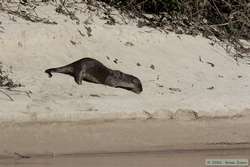
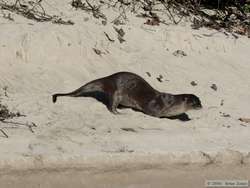
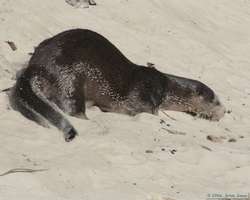 In the afternoon, we went by boat up the Rio Cristalino. We primarily saw things that we'd seen before, but we got really lucky and got to see a river otter (Lutra longicaudis) go up onto a small beach and roll around in the sand. As soon as he saw us, he made a bee-line for the water. Fabricio said it's rare to get such a good look at the river otters out of the water, as they are very shy here. We saw another otter latter, but it was in the water and dove quickly once it saw us.
In the afternoon, we went by boat up the Rio Cristalino. We primarily saw things that we'd seen before, but we got really lucky and got to see a river otter (Lutra longicaudis) go up onto a small beach and roll around in the sand. As soon as he saw us, he made a bee-line for the water. Fabricio said it's rare to get such a good look at the river otters out of the water, as they are very shy here. We saw another otter latter, but it was in the water and dove quickly once it saw us.
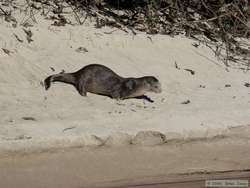
|
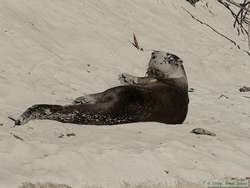
|
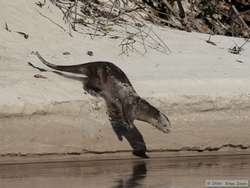
|
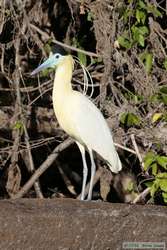 We motored up the river a ways, then the boat driver cut the engine and we largely just drifted back to the lodge, with motor assistance on occasion.
We motored up the river a ways, then the boat driver cut the engine and we largely just drifted back to the lodge, with motor assistance on occasion.
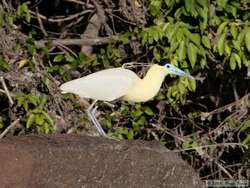 One of the highlights of the evening was seeing the capped heron, which are amazingly beautiful. They are also rather shy creatures, and they don't stick around for long once humans arrive. We got a good look at some Scarlet Macaws as well.
One of the highlights of the evening was seeing the capped heron, which are amazingly beautiful. They are also rather shy creatures, and they don't stick around for long once humans arrive. We got a good look at some Scarlet Macaws as well.
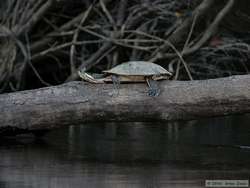
|
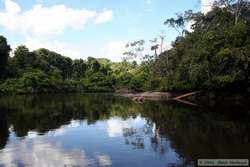
|
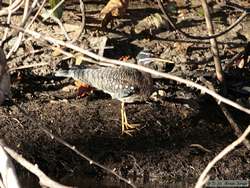
|
At dinner we were joined by Amy, the youngest person here at the lodge. At 15, she is quite the extraordinary child. She plopped herself right down in the middle of the five of us and just started chatting away. She was there with friends of her parents, and is big into butterflies and photography. She was very bright, and I suspect that she is going to go far in life.
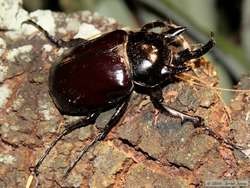
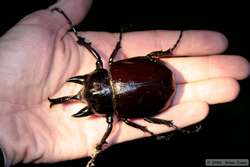 In the evening, someone started an insect trap to see what would come in. The most exciting catch was a huge rhinoceros beetle. I held it in my hands and it was about half the size of my whole palm, and I have really large hands! The rhinoceros beetle was amazingly strong too, with large hooked feet. It took quite a bit of effort to extricate it from my hand. A little research reveals that the rhinoceros beetle can support 850 times it's own weight on it's back, making it the strongest creature on earth (proportionally speaking of course). What an amazing insect!
In the evening, someone started an insect trap to see what would come in. The most exciting catch was a huge rhinoceros beetle. I held it in my hands and it was about half the size of my whole palm, and I have really large hands! The rhinoceros beetle was amazingly strong too, with large hooked feet. It took quite a bit of effort to extricate it from my hand. A little research reveals that the rhinoceros beetle can support 850 times it's own weight on it's back, making it the strongest creature on earth (proportionally speaking of course). What an amazing insect!
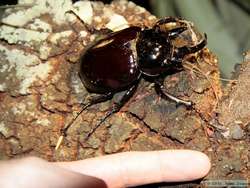
|
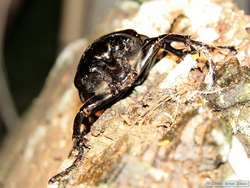
|
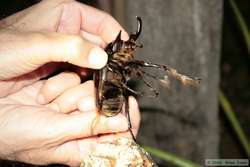
|
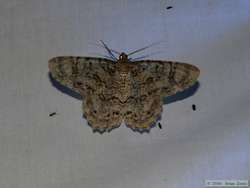
|
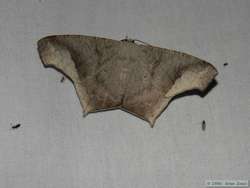
|
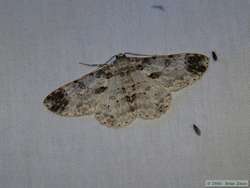
|
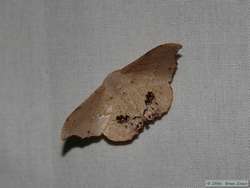
|
Species list for the day (41 birds, 3 mammals, 2 reptiles, 1 amphibian):
Anhinga (Anhinga anhinga)
Capped Heron (Pilherodius pileatus)
Striated Heron (Butorides striatus)
Green Ibis (Mesembrinibis cayennensis)
Black Vulture (Coragyps atratus)
Tiny Hawk (Accipiter superciliosus)
Great Black-Hawk (Buteogallus urubitinga)
Bat Falcon (Falco rufigularis)
Spix's Guan (Penelope jacquacu)
Red-throated Piping-Guan (Pipile cujubi)
Sunbittern (Eurypyga helias)
Blue-and-yellow Macaw (Ara ararauna)
Scarlet Macaw (Ara macao)
Blue-winged Macaw (Ara maracana)
Painted Parakeet (Pyrrhura picta)
White-bellied Parrot (Pionites leucogaster)
Blue-headed Parrot (Pionus menstruus)
Orange-winged Parrot (Amazona amazonica)
Mealy Parrot (Amazona farinosa)
Pearly Parakeet (Pyrrura lepida)
Little Cuckoo (Piaya minuta)
Green Kingfisher (Chloroceryle americana)
Paradise Jacamar (Galbula dea)
Black-fronted Nunbird (Monasa nigrifrons)
White-fronted Nunbird (Monasa morphoeus)
Swallow-wing (Chelidoptera tenebrosa)
Red-necked Araçari (Pteroglossus bitorquatus)
Channel-billed Toucan (Ramphastos vitellinus)
Wing-banded Antbird (Myrmornis t. torquata)
Screaming Piha (Lipaugus vociferans)
Spangled Cotinga (Cotinga cayana)
Bare-necked Fruitcrow (Gymnoderus foetidus)
Gray Elaenia (Myiopagis caniceps
Swallow Flycatcher (Hirundinea bellicosa)
Long-tailed Tyrant (Colonia colonus)
White-winged Swallow (Tachycineta albiventer)
M Purple Martin (Progne subis)
Blue-and-white Swallow (Notiochelidon cyanoleuca)
White-banded Swallow (Atticora fasciata)
Southern Rough-winged Swallow (Stelgidopteryx ruficollis)
Red-capped Cardinal (Paroaria gularis)
Southern Red-necked Night Monkey (Aotus nigriceps )
White-whiskered Spider Monkey (Ateles marginatus )
Southern River Otter (Lutra longicaudis )
South American River Turtle (Podocnemis spp. )
Amazon Racerunner aka Green Ameiva (Ameiva ameiva)
Geckos (Family Gekkonidae)
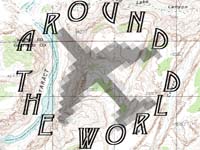 |
 |